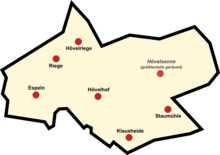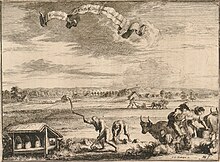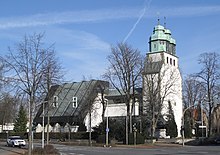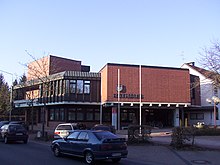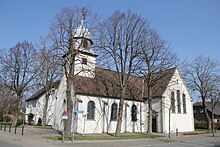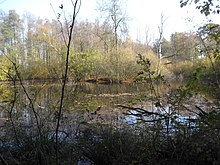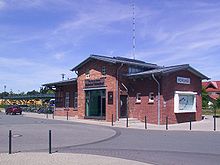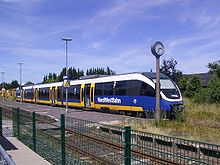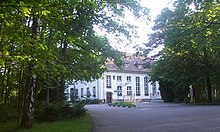Hövelhof
| coat of arms | Germany map | |
|---|---|---|

|
Coordinates: 51 ° 49 ' N , 8 ° 39' E |
|
| Basic data | ||
| State : | North Rhine-Westphalia | |
| Administrative region : | Detmold | |
| Circle : | Paderborn | |
| Height : | 106 m above sea level NHN | |
| Area : | 70.74 km 2 | |
| Residents: | 16,281 (Dec. 31, 2019) | |
| Population density : | 230 inhabitants per km 2 | |
| Postal code : | 33161 | |
| Primaries : | 05257, 05294 | |
| License plate : | PB, BÜR | |
| Community key : | 05 7 74 024 | |
| LOCODE : | DE HVF | |
| Community structure: | 6 districts | |
| Address of the municipal administration: |
Schlossstrasse 14 33161 Hövelhof |
|
| Website : | ||
| Mayor : | Michael Berens ( CDU ) | |
| Location of the municipality Hövelhof in the Paderborn district | ||
Hövelhof is a municipality in North Rhine-Westphalia , Germany and belongs to the Paderborn district . Since March 14, 2012, Hövelhof has been allowed to use the official addition Sennegemeinde .
geography
Geographical location
Hövelhof is located in the northeast of North Rhine-Westphalia , in the center of East Westphalia-Lippe ( Detmold administrative district ) and in the north of the Paderborn district . In terms of natural surroundings, the municipality is located in the Senne , the eastern part of the Westphalian Bay . The municipality is mostly flat.
The predominant body of water in the municipality is the Ems , whose springs are located immediately north of the municipality boundary in the Stukenbrock area. Other rivers that originate in the municipality or cross it are the Haustenbach , the Bonebach, the Krollbach , the Kastenbach, the Schwarzwasserbach , the Furlbach , the Holtebach and the Hallerbach . The center of Hövelhof is at 109 m above sea level.
See also: Natural spaces in OWL , waters in OWL
geology
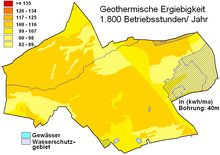
The municipality is located in the "large Emsterrasse", which consists of a series of gravels , sands and silts from the Vistula ice age close to the surface . Filling sands and basin clays from the Saale cold period , which were created by meltwater deposits, or sediments from the end of the Holstein warm period often lie at an increasing depth . On the surface itself there are often embankments, drifting sands, dam beds, dunes and moors from the end of the Vistula ice age and the post-ice age.
Under the layers formed by the Ice Age there is bedrock, which consists of clay marl stones (" Emscher marl"), marl , marl-limestone and limestone from the Middle Ages , which slope slightly to the west . Below is a plinth made of folded rocks from the ancient world ( Devonian , Carboniferous ).
Groundwater occurs moderately in the unconsolidated rocks of the Ice Age, and in larger quantities in the channels of the Emsterrasse. The uppermost groundwater level is formed in the loose rock. Between these and the second groundwater level in the solid rock of the lower Upper Cretaceous, there are locally poorly permeable deposits. In this second groundwater level, water is increasingly salinized from northeast to southwest. Sand and in part also gravel are abundant in the deposits of the Ems and its tributaries and are suitable for use as wall and filler sand.
The soils in the municipal area consist of groundwater influenced soils ( gleye , fens ) and about five to ten meters higher, drier terrace sands of the Pleistocene . A frequent change between soils from post-glacial river and stream deposits and soils made from boulder clay and drifting sands can be found here. These changes give the landscape a slightly undulating profile. At locations with groundwater levels between 60 and 100 cm below the surface, podsol gleyes formed in nutrient-poor sands , in which horizons of turf iron or cast stone have solidified and are therefore disadvantageous for agriculture . Agricultural use was only possible after these layers had broken down and in some cases plague and drainage. At locations with groundwater levels between 100 and 200 cm below the surface, heavily podsolized gley podsols or podsols formed if there was no groundwater connection. These locations only allow low-yield and drought-prone arable farming.
Hövelhof is moderately to very well suited for the use of geothermal heat sources by means of a geothermal probe and heat recovery through heat pump heating (see the adjacent map).
Expansion and use of the municipal area
The community of Hövelhof, classified as a “large rural community”, covers an area of 70.67 km², of which 19.72 km² belong to the military training area and 3.34 km² are community forest. The largest share of the area is made up of agricultural and forest areas with a total of around 78.4%. The largest extension in north-south direction is about 9.8 km, in east-west direction about 13.2 km.
| Area according to type of use |
Agricultural area |
Forest area |
Building, open and operational space |
Traffic area |
Surface of water |
Sports and green space |
other use |
|---|---|---|---|---|---|---|---|
| Area in km² | 33.88 | 21.57 | 6.19 | 3.73 | 0.96 | 1.12 | 3.27 |
| Share of total area | 47.91% | 30.50% | 8.75% | 5.28% | 1.36% | 1.58% | 4.62% |
Neighboring communities
Hövelhof borders, starting in the northwest in a clockwise direction, on the cities of Verl (district Kaunitz ) and Schloss Holte-Stukenbrock of the district of Gütersloh , the community of Schlangen (district of Oesterholz-Haustenbeck ) of the district of Lippe and the cities of Bad Lippspringe , Paderborn (districts of Sennelager and castle Neuhaus ) and Delbrück (districts Steinhorst , Westerloh , Lippling and Ostenland ) of the Paderborn district .
Community structure
For historical reasons, the municipality of Hövelhof is divided into the districts Hövelhof, Klausheide , Staumühle , Espeln , Riege , Hövelriege and Hövelsenne . However, the main statute of the municipality does not differentiate between these districts. There are also the locations Bentlake, Untersenne and Hasendorf east of the town center. In the course of the expansion of the Senne military training area , almost all of the Hövelsenne district in the east of Hövelhof, which was built in the middle of the 17th century in the form of Riegen ( Reihendorf ), had to be cleared from 1939. Including the school from 1800 (1966) and the St. Joseph's Church, which was only built in 1923 (1974), 135 houses and courtyards had to be cleared.
history
The name of the community is derived from an old Vollmeierhof of the same name , which dates back to at least the year 1000. The first documentary mention of the Hövelhof in the north-eastern Delbrücker Land comes from 1446. Almost 200 years later, in 1645, the last Meier zu Hövel died childless. The Hövelhof therefore fell back to the sovereign, the Prince-Bishop of Paderborn. Around 1659 the "New Village" (Niendorp) was built on the Krollbach . In addition to the courtyard house the hunting lodge of 1661 Paderborn prince bishops built and early 18th century, the construction of the first Hövelhofer done church within the moat of the castle. It was completed in 1706. Nine years later the Catholic parish of Hövelhof was founded and the parish of the mother church St. Johannes Baptist Delbrück was established. In 1782 a larger church was built on the site of today's parish church. After the reign of the Prince-Bishop of Paderborn ended in 1802, the Delbrücker Land became Prussian. Five years later the Delbrücker Land was divided into six municipalities under the rule of Jérôme Bonaparte. Hövelhof got its independence as a political municipality. In the 1820s, a bog fever epidemic broke out in Hövelhof, killing around 800 citizens. Another major population loss occurred in 1851 due to famine and typhus in Hövelhof and Stukenbrock. In 1903 the "Hövelhof" burned down. In 1957 the Protestant Johanneskirche was built and consecrated. Two years later, parts of the Ostenland community (Bentlake, Alkenbrink and the Klausheide district settlement) were incorporated and in 1975 with the dissolution of the office, Neuhaus Hövelhof Castle became a free community. Parts of the previous community of Ostenland ( Espeln and Klausheider settlement ) were incorporated in the course of this. On October 31, 1978 passenger traffic via Verl to Gütersloh -Nord with the Teutoburg Forest Railway was stopped. In 1982 the Ev. Johannes parish independently.
Religions
In Hövelhof there is the Catholic parish of St. John Nepomuk with Pfarrvikarieämtern in Heart of Jesus in Hövelriege and Sacred Heart in Espeln and the Protestant St. John Parish with the Johannes church at the Breslauer Strasse.
An indication of the distribution of religions can be the denominational affiliation of Hövelhof students. In 2007, 1008 of the students were Catholic, 306 Protestant and 56 Islamic. 139 said they belonged to another denomination, 97 did not belong to any denomination.
In 1731 a brotherhood of Christ's fear of death was founded in Hövelhof , praying for a gracious death for himself and his fellow brothers.
Incorporations
Klausheide has belonged to Hövelhof since the community was founded in 1807. On October 1, 1958, the district settlement, Bentlake and Alkenbrink were reclassified from the Ostland community in the Delbrück office to Hövelhof.
According to the Sauerland / Paderborn law , which regulates the local reorganization on January 1, 1975, the office of Schloss Neuhaus was dissolved and Hövelhof became an independent municipality with its own administration. The district Espeln and the Klausheider settlement were assigned from the Ostland community to the Hövelhof community.
Population development
|
|
¹ census result
The population figures refer to the respective territorial status of the municipality.
politics
Municipal council
The municipality council in Hövelhof currently consists of 34 members. In addition, the mayor is the council chairman. The following table shows the local election results since 1975:
| 2014 | 2009 | 2004 | 1999 | 1994 | 1989 | 1984 | 1979 | 1975 | ||||||||||
|---|---|---|---|---|---|---|---|---|---|---|---|---|---|---|---|---|---|---|
| Political party | Seats | % | Seats | % | Seats | % | Seats | % | Seats | % | Seats | % | Seats | % | Seats | % | Seats | % |
| CDU | 22nd | 67.45 | 23 | 67.20 | 24 | 71.99 | 25th | 73.47 | 21st | 60.29 | 21st | 60.13 | 23 | 65.53 | 24 | 73.63 | 27 | 77.53 |
| SPD | 6th | 17.08 | 7th | 21.48 | 9 | 25.34 | 7th | 19.20 | 9 | 26.09 | 8th | 24.16 | 6th | 19.93 | 7th | 20.73 | 6th | 17.77 |
| GREEN | 4th | 10.60 | - | - | - | - | 2 | 7.33 | 3 | 9.64 | 2 | 7.17 | 2 | 7.00 | - | - | - | - |
| FDP | 2 | 4.87 | 4th | 11.32 | 1 | 2.67 | - | - | 0 | 4.00 | 2 | 8.54 | 2 | 7.54 | 2 | 5.64 | 0 | 4.70 |
| Total¹ | 34 | 100 | 34 | 100 | 34 | 100 | 34 | 100 | 33 | 100 | 33 | 100 | 33 | 100 | 33 | 100 | 33 | 100 |
| voter turnout | 53.63 | 51.49 | 56.84 | 52.90 | 82.21 | 63.93 | 68.63 | 73.13 | 88.72 | |||||||||
¹ without taking into account rounding differences
mayor
- 1808–1812 Jost Heinrich Hachmann called Apelmeier (Ortsmaire, from 1812 local civil servant)
- 1815–1819 Johannes Heinrich Gröpper called Dieksmeier (local civil servant)
- 1819–1849 Heinrich Gröpper called Unterramsel (local civil servant)
- 1849–1857 Heinrich Mertensmeier (local civil servant)
- 1857–1886 Ferdinand Gröpper called Rüllenbrink (local civil servant)
- 1886–1910 Heinrich Rodehut called Oberramsel (head)
- 1910–1927 Josef Westhof called Holländer
- 1927–1934 Wilhelm Bee
- 1934–1945 Georg Pöpsel
- 1945–1948 Ferdinand Henkemeyer called Unterramsel, center
- 1948–1956 Wilhelm Bee
- 1956–1963 Johannes Liemke
- 1963–1976 Josef Förster, CDU, former mayor and honorary citizen of the Hövelhof community after his term of office
- 1976–1999 Heinz Sallads, CDU, former mayor and honorary citizen of the Hövelhof community after his term of office
- 1999-2004 Werner Thor, CDU
- since 2004 Michael Berens, CDU
Coat of arms, seal and banner
The municipality of Hövelhof was granted the right to use a coat of arms and a seal with this coat of arms in a certificate from the Interior Minister of North Rhine-Westphalia dated June 25, 1962.
- “In green, a silver (white) wave bar above a silver (white) hunting horn. A red cross in the silver (white) head of the shield. "
Meaning:
The coat of arms of the municipality Hövelhof shows historical and geographical symbols:
- The cross in the upper field indicates the bishop's cross of the prince-bishops of Paderborn, who were sovereigns from the Middle Ages until the secularization in 1803.
- The wavy line symbolizes Hövelhof's wealth of brooks, the most important of which is the Ems .
- The hunting horn indicates the construction of the hunting lodge on the Hövelhof by Prince-Bishop Dietrich Adolf von der Recke in 1661. The location of the castle initially led to the establishment of the Catholic parish and ultimately to the elevation of Hövelhof to an independent parish in 1807.
- The predominant green in the coat of arms represents the community's wealth of forest and green areas.
Seal description:
- "The municipality of Hövelhof has an official seal with the municipality's coat of arms and the inscription" Municipality of Hövelhof Krs. Paderborn "."
Furthermore, the municipality of Hövelhof was granted the right to carry a banner with a certificate from the District President Detmold dated September 16, 1971.
Banner description:
- "Striped lengthways by green and white with the coat of arms of the municipality in the upper third."
Town twinning
The municipality of Hövelhof has been twinning with Verrières-le-Buisson in France since 1971 . Every year, visits to the befriended churches take place at Whitsun. Student exchanges between the two communities are also held annually.
Since August 16, 2007, the municipality of Hövelhof and the 4th / Panzer Battalion 203 of Panzerbrigade 21 from neighboring Augustdorf have also had a partnership.
The community is also a member of the Federation of European Napoleonic Cities .
A partnership between Hövelhof and the football club DSC Armina Bielefeld has existed since summer 2018.
Culture and sights
Museums
The village school museum can be found in the Riege district. It is housed in a 200 year old school that is a listed building. There is still a school bell on the roof and the garden is still unchanged. Over 1200 historical school books and equipment and tools from the classroom are on display. During painting in 1950, a golden ABC from the 19th century was uncovered, which conveys 24 rules of life for the letters.
The Heimatzentrum OWL consists of the Heimathaus and the House of Historic Crafts. The latter was built in 2005 as a volunteer. Various old handicrafts such as basket makers, rope makers and village blacksmiths are shown there. The Heimathaus is a typical Hövelhof building. A bakery has also been set up here so that you can bake your own bread at various events. The entire facility can be viewed by telephone arrangement.
music
Church choirs are active in the communities of Hövelhof and Hövelriege. The Kolping Family Hövelhof has an à la carte choir ; There are men's choirs in Hövelsenne and Espeln .
In Hövelhof there is an accordion orchestra, a hunting horn corps and a wind orchestra. There is a brass band and a Schützen-Tambour-Corps in the Hövelriege district. The Emslandjäger are a band whose members live in Espeln and Steinhorst.
Buildings
- The parish church of St. Johannes Nepomuk Hövelhof is the fourth church building in the community. Since the previous churches were always in poor condition and too small for the up-and-coming community of Hövelhof, the fourth Hövelhof parish church was built in 1977.
- In the town center, not far from the Catholic parish church, is the former hunting lodge of the prince-bishops of Paderborn . The entire facility was formerly of moats surrounded. The main house, built in 1661 by Prince-Bishop Dietrich Adolf von der Recke , is a simple two-storey half - timbered building with a gable roof . Based on the example of the mansion Haus Außenel near Wiedenbrück , it has four diagonally placed stand bay windows at the corners. In 1780 the porch on the entrance side was built. The right of the two outbuildings is marked with the year 1774. The former castle is now used as a Catholic rectory.
- Parish church Herz-Jesu Hövelriege
- Parish church Herz-Jesu Espeln
- The Ramselhof is one of the oldest manors in Hövelhof. The beginnings of the court's history go back to the 12th century. The preserved courtyard house was built in 1744 and is located in a park. The manor is privately owned, but there is the opportunity to get married here once a month.
Parks
In Hövelhof there is the Verrières park, which was named after the twin town in France . The hiking trails in Moosheide and Hövelhofer Forest are used by the citizens for recreation. There is a small, non-public park around the Ramselhof.
Nature reserves
In Hövelhof there are a total of five nature reserves, three of which are exclusively in the municipality and two more in cross-town locations.
The Paderborn-Senne District Biological Station looks after the Moosheide nature reserve . Dunes and dry heather characterize this 440 hectare area. In addition, there are sandy grasslands and a mixed forest of oak and birch . About 285 hectares are in Hövelhof, the remaining part in Schloss Holte-Stukenbrock .
The Ramselbruch is a 55 hectare nature reserve northwest of Hövelhof. It consists of forests that are typical of the Senne area. There are also heather bogs, dunes and wet meadows . The area is one of the oldest nature reserves in East Westphalia-Lippe.
The Rixelbruch nature reserve consists of an alder forest on a sandy subsoil in the valley of the Furlbach north of the Riege district and covers around 5.2 hectares.
The nature reserve Apels Teich stretches from Salvatorstraße to the A33 motorway and is almost 40 hectares in size. The 2.3 hectare older part consists of a heather pond, a wet alder quarry forest typical of the Senne , and a sand dune with an oak-birch forest . It represents the remainder of an original alpine landscape before the pine tree penetrated , which has shaped the alpine landscape for the past 300 years.
Between Hövelhof and Ostenland there is the almost 122 hectare nature reserve Erdgarten-Lauerwiesen, which consists primarily of wet meadows . Parts of the species-rich protected area extend into the area of the city of Delbrück.
Sports clubs and other associations

In Hövelhof there are over 20 clubs that offer the population sporting activities. In addition to the classic ball sports such as soccer , handball , volleyball , tennis and table tennis, there are offers such as badminton , horse riding and the martial arts Ju-Jutsu . Cycling, a swimming club, a DLRG local group and integrative and rehabilitation sports round off the sporting area. The HSG Augustdorf / Hövelhof is an amalgamation of the handball departments of the TuSG Augustdorf and HC Hövelhof and currently plays in the Oberliga Westfalen. The team's greatest success is promotion to the 2nd Bundesliga for the 2002/03 season.
The association with the largest number of members by far is the St. Hubertus Schützenbruderschaft Hövelhof e. V. with 2,037 members (as of 2009). The battalion is subdivided into five companies, with respective platoons and groups, from which in turn a shooting sports division, the young rifle division, the flag-waving group, a brass band, a marching band and the prince-bishop's gunmen emerge. In September 2009 the Hövelhofer Schützenbruderschaft organized the Federal Rifle Festival . 30,000 shooters took part in the event in the Hövelhof town center.
Events and festivals
Every Thursday morning there is a weekly market on the Hövelmarkt at the church. At the beginning of April, the Espelner Mofa race takes place in the district of the same name. The Spring Festival is celebrated on April 30th and May 1st on the Hövelmarkt. At the end of June the annual shooting festival of the St. Hubertus shooting association Hövelhof takes place. The St. Libori-Bürgerschützen Hövelriege- Liemke celebrate their shooting festival at the beginning of August. Also in August, the Paderborn-Senne district biological station celebrates the heather blossom festival on the grounds of the heather sheep farm in the Senne. In September, the Espeln Citizens Association organizes the Heimat- und Harvest Festival in Espeln . On the first weekend in October, the Hövelhof tourist office organizes the traditional Hövelmarkt festival and in December the Christmas market in the center of Hövelhof.
Culinary specialties
The Hövelhofer Sennebier, which is served in some local restaurants and is available from local beverage suppliers, is a regional specialty. Sennebier is brewed in Detmold by the Strate brewery .
Economy and Infrastructure
traffic
Rail and bus transport
The station Hövelhof and the breakpoint Hövelriege are on the Senne-Bahn ( KBS 403 ). The route is served by the regional train of the same name 74 Bielefeld - Schloß Holte - Paderborn. Another stop in Klausheide is no longer used. The local rail passenger transport (SPNV) is carried out by the NordWestBahn with diesel multiple units of the type Bombardier Talent .
Until 1978 Hövelhof station was also served by passenger trains on the Ibbenbüren – Hövelhof line of the Teutoburg Forest Railway (TWE), which was completed in 1903 . The route ran from Gütersloh via Verl and Kaunitz . A reactivation of local passenger transport between Gütersloh and Verl is currently being discussed for the freight route owned by Captrain Germany today; an extension between Kaunitz and Hövelhof is not (yet) planned. On the first Sunday in December, however, a steam locomotive runs on the TWE every year with the Teuto-Express as a museum train from Gütersloh to the Hövelhofer Nikolausmarkt.
In the road passenger transport operate regional buses to Paderborn, Gütersloh and Stukenbrock (and then change to Bielefeld- Brackwede ). The Hövelhofer local bus (HOB) has been connecting all districts with each other since 1997. The local bus has replaced the school bus in Hövelhof . All trips became public and additional trips were introduced during the holidays and in the afternoon. The local bus in Hövelhof could become a model for numerous smaller municipalities in order to create inexpensive basic services with public transport with little effort. There is a night bus from Paderborn on weekends and before selected public holidays .
The tariff of the local transport association Paderborn-Höxter applies to all local public transport , in the direction of Bielefeld a transitional tariff to the association tariff “Der Sechser” ( OWL Verkehr GmbH) and the NRW tariff across the tariff area .
Streets
The A 33 Bielefeld-Bad Wünnenberg motorway crosses the municipality with two exits (Stukenbrock-Senne and Paderborn-Sennelager) in the immediate vicinity of the village.
air traffic
The Paderborn-Lippstadt airport is about 29 km away in Bueren - Ahden .
Bicycle traffic
Hövelhof is the starting point of the Ems cycle path . In addition, the European cycle path R1 and the Senne cycle path run through the municipality.
media
Print media
Two regional daily newspapers are represented in Hövelhof, on the one hand the local edition of the Westfälischer Volksblatt , a regional name of the Westfalen-Blatt, and on the other hand the Neue Westfälische with a regional section. Both newspapers get their coat from their respective coat editorial offices in Bielefeld. In addition, the quarterly magazine Die Warte for the Paderborn and Höxter districts appears in the Hochstift Paderborn with articles on regional history, literature and art.
The Hövelhofer Rundschau magazine appears monthly. The publisher is the Hövelhof tourist office. Similar magazines from the neighboring communities of Verl and Schloß Holte-Stukenbrock are also available in Hövelhof.
Radio and television
Hövelhof belongs to the reporting area of the regional studio Bielefeld of the WDR and of Radio Hochstift , which it covers in the reporting as local radio.
Public facilities
In the volunteer fire Hövelhof are active about 80 firefighters. The youth fire brigade consists of 23 young people aged 12–17 years.
The Hövelhof community has had its own indoor swimming pool with a 25-meter pool since 1972. It is visited by around 53,000 bathers every year.
The community's children's and youth center, called Haus der Jugend - HOT Hövelhof , is around 900 square meters in size and has a café, a computer room, crawling rooms, various play equipment such as table football etc. and a large outdoor area with a skate facility, mini football field and barbecue facilities. From Monday to Saturday, children and young people can spend their free time there.
The Hövelhof community is responsible for a public library together with the Catholic Church .
The Hövelhof correctional facility was founded in the Staumühle district as an open youth penal system in 1948 and expanded in 1993 to include a nursing department. The juvenile prisoners are usually accommodated in residential units with two to three residents, but 40 solitary confinement rooms are also available. The physically separate nursing department has 31 detention places.
The Paderborn-Senne District Biological Station operates a heather sheep sheep on the border of the military training area .
The Salvator-Kolleg is a Caritas youth home in the Archdiocese of Paderborn for inpatient child and youth welfare for boys from the age of 12, with its headquarters in Hövelhof.
education
In Hövelhof there are five communal kindergartens and three kindergartens that are run by Catholics. In addition, there are three primary schools, two of which - the mill school and the parish school - Catholic parochial schools are. The Krollbach School is an all-day school; Hauptschule lessons are given on it. The Franz Stock Realschule is adjacent to the secondary school . Gymnasiums are located in the immediate neighboring communities in Verl, Holte-Stukenbrock Castle, Rietberg, Delbrück, Neuhaus Castle and Paderborn.
The community Hövelhof has belonged to the adult education center association Büren, Delbrück, Salzkotten, Bad Wünnenberg since June 1st, 2010. So far, the tasks of the adult education center have been carried out by the Hövelhof e. V. carried out. The Volksbildungswerk continues to be active in the community's cultural tasks. These include the Low German Circle, the accordion orchestra, the youth wind orchestra, the literary working group, the art group and the study trips. In 2007, a total of 1573 pupils were taught at the municipal schools with 95 teachers, 46.9% of them at primary schools, 20.7% at Hauptschule, 31.3% at Realschule and 1.1% at special schools.
Hövelhof company
Hövelhof companies are represented in the following sectors: mechanical engineering, metal processing, packaging and cardboard packaging, plastics, pharmaceuticals and food supplements, illuminated advertising, furniture and sales as well as the production of coffee machine systems. In addition, there are the typical craft businesses.
Personalities
Honorary citizen
- Josef Henrichsmeyer (1891–1967), founder of geha-Möbelwerke, largest company in Hövelhof, military leader of the volunteer fire brigade and colonel of the riflemen
- Josef Förster (1906–1991), former mayor of Hövelhof
- Heinz Sallads (1931–2006), former mayor of Hövelhof
Sons and daughters of the church
- Reinhard Marxkors (* 1932), dentist and university professor
- Heinz Pieces (* 1940), former world record holder in cycling with the longest cycled route
- Ludger Hoffmann (* 1951), Germanist at the TU Dortmund
literature
- Johannes Buschmeier, Carsten Tegethoff: Hövelhof: Pictures to history. Regional Verlag Thomas P. Kiper, 2007, ISBN 3-936359-24-5 .
- Johannes Buschmeier: Streets and ways in Hövelhof. Bonifatius, Paderborn 1995.
- Josef Heller, Karl-Heinz Brake: For the life of the world: Thoughts on the tabernacle in the parish church of St. Johannes Nepomuk at Hövelhof. Catholic parish office of St. Johannes Nepomuk, 1989.
- 275 years of St. Johannes Nepomuk zu Hövelhof: Hövelhof's parish churches under the patronage of the saint since 1706. Catholic parish office of St. Johannes Nepomuk, 1981.
- Hövelsenne: history e. Church u. their community. Catholic Filial Parish St. Joseph, 1974.
- Philipp Schniedertüns: Hövelhof. Schöningh, 1952.
Web links
- Link catalog on Hövelhof at curlie.org (formerly DMOZ )
- Hövelhof in the Westphalia Culture Atlas
Individual evidence
- ↑ Population of the municipalities of North Rhine-Westphalia on December 31, 2019 - update of the population based on the census of May 9, 2011. State Office for Information and Technology North Rhine-Westphalia (IT.NRW), accessed on June 17, 2020 . ( Help on this )
- ↑ Approval of the additional designation (PDF; 92 kB)
- ^ Geological Service North Rhine-Westphalia: Geoscientific description of the municipality Hövelhof ( Memento from May 13, 2014 in the Internet Archive )
- ↑ Using geothermal energy - geothermal study provides planning basis ( Memento from September 14, 2005 in the Internet Archive ) (PDF; 360 kB) Geological Service NRW
- ↑ a b State Office for Data Processing and Statistics North Rhine-Westphalia : Municipal profile Hövelhof ( Memento of the original from May 5, 2008 in the Internet Archive ) Info: The archive link was automatically inserted and not yet checked. Please check the original and archive link according to the instructions and then remove this notice.
- ^ A b Geographical Commission for Westphalia (ed.): Geographisch-Landeskundlicher Atlas von Westfalen, Topic X Administration and Management, double sheet state and municipal administrative structure , Münster 1990. Cf. Gerhard Henkel : History and Geography of the Büren District. Paderborn 1974, p. 101 f. and card insert.
- ^ Wilhelm Honselmann: Hövelhof, Meier zu Hövel, Hövelmeier and Hövelmann. In: Genealogy vol. 35 (1986) pp. 257-269
- ↑ Street names of the municipality Hövelhof and their meaning: Obere Bielefelder Landstraße ( Memento of the original from October 30, 2014 in the Internet Archive ) Info: The archive link was inserted automatically and has not yet been checked. Please check the original and archive link according to the instructions and then remove this notice. (PDF; 16 kB)
- ↑ Map of the Principality of Paderborn from 1672 in the Monumenta Paderbornensia : Commons
- ↑ Senne portal: History of Hövelhof 2 ( Memento of the original from May 3, 2014 in the Internet Archive ) Info: The archive link has been inserted automatically and has not yet been checked. Please check the original and archive link according to the instructions and then remove this notice.
- ↑ Street names of the Hövelhof community and their meaning: Dr-Schmidt-Straße ( Memento of the original from March 4, 2016 in the Internet Archive ) Info: The archive link was inserted automatically and has not yet been checked. Please check the original and archive link according to the instructions and then remove this notice. (PDF; 13 kB)
- ↑ Street names of the municipality Hövelhof and their meaning: Wassermannsweg ( Memento of the original from March 4, 2016 in the Internet Archive ) Info: The archive link was inserted automatically and has not yet been checked. Please check the original and archive link according to the instructions and then remove this notice. (PDF; 11 kB)
- ↑ About the state of emergency in a part of Westphalia . In: Schlesisches Kirchenblatt, 1851, No. 40, pp. 499–500.
- ↑ Evangelical Johannes-Kirchengemeinde: Chronicle of the church congregation
- ↑ Information und Technik NRW: Students at general schools in NRW according to religious affiliation. (No longer available online.) Archived from the original on April 7, 2014 ; Retrieved May 3, 2014 . Info: The archive link was inserted automatically and has not yet been checked. Please check the original and archive link according to the instructions and then remove this notice.
- ↑ Stephanie Reekers: The regional development of the districts and communities of Westphalia 1817-1967 . Aschendorff, Münster Westfalen 1977, ISBN 3-402-05875-8 , p. 247 .
- ^ Federal Statistical Office (ed.): Historical municipality directory for the Federal Republic of Germany. Name, border and key number changes in municipalities, counties and administrative districts from May 27, 1970 to December 31, 1982 . W. Kohlhammer, Stuttgart / Mainz 1983, ISBN 3-17-003263-1 , p. 328 .
- ↑ State database NRW; Election results for the municipality code 05774024
- ^ State Office for Information and Technology in North Rhine-Westphalia: Local elections
- ↑ Coat of arms of the municipality Hövelhof
- ↑ a b c main statute of the municipality Hövelhof (PDF)
- ↑ Heimatzentrum OWL: Internet presence
- ↑ Ramselhof in Hövelhof ( Memento of the original dated February 8, 2016 in the Internet Archive ) Info: The archive link was inserted automatically and has not yet been checked. Please check the original and archive link according to the instructions and then remove this notice.
- ↑ Biological station district Paderborn - Senne e. V.
- ↑ Query of the course book route 403 at Deutsche Bahn.
- ↑ Local bus is already in the black . In: Neue Westfälische , September 5, 1998.
- ^ Municipality of Hövelhof: Portrait of the Hövelhof indoor swimming pool
- ↑ https://www.hoevelhof.de/de/index.php
- ↑ Municipality of Hövelhof: Josef Henrichsmeyer (PDF; 17 kB)
- ^ Municipality of Hövelhof: Council meeting on February 10, 2000




